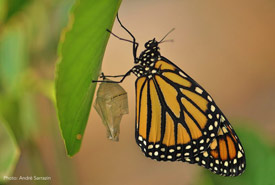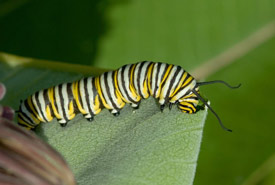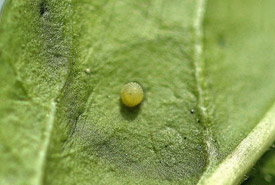Where are the monarchs?

Monarch butterfly (Photo by André Sarrazin)
Even as we delve deeper into the mysteries of the monarch butterfly’s migration, we still know very little about its breeding habits in the northern part of its range. To get to the bottom of the mystery, a group of experts has gotten together in a major cross-Canada research project: Mission Monarch.
Mission Monarch is dedicated to the protection of the monarch butterfly, a magnificent – but increasingly diminished – species. And now Canadians can also lend a hand in this mission.
A troublesome situation

Monarch caterpillar (Photo by Maxim Larrivée)
There are two populations of migrating monarchs in Canada: one west of the Rockies and the other in the east. Annual assessments of those populations at their wintering grounds (in California for the western population and in Mexico for the eastern) show a disturbing pattern. Whereas the eastern population was estimated to number almost a billion individuals in the late 1990s, today the population totals only 200 million individuals. In the west the situation is no brighter, with a population that has dropped from 1.2 million individuals to 271,000 in two decades.
In short, the migrating monarch populations in North America are in decline. Habitat destruction is the primary factor accounting for this decrease in numbers. Deprived of part of their wintering and breeding habitats, and facing an increasing number of threats during migration, monarch butterflies have been declining over the past few decades and are now listed as “Special Concern” in Canada.
Researchers from the Montreal Insectarium (one of the four Space for Life institutions), Institut de recherche en biologie végétale, University of Ottawa, Université du Québec à Rimouski and University of Calgary are working together on a new initiative to help protect monarchs in North America.
The goal? To determine the butterfly’s ideal breeding grounds in order to influence the development of a national conservation plan for the monarch. The project is ambitious and provides grounds for hope, but to actually work it will need the help of…Canadians!
Citizen science is gaining in popularity in North America. More and more nature enthusiasts are taking part in research by carrying out inventories, participating in tagging activities or reporting their observations in nature.
A challenging mission

Monarch egg on a leaf (Photo by André Sarrazin)
The initial phase of the study, already underway, consists in mapping the monarch’s range in North America with the help of computer models. The same work is also being carried out for seven species of milkweed, the plants on which the female monarch lays her eggs. Thanks to those models, researchers can determine the environments most conducive to the butterfly’s breeding.
The next phase involves checking the presence or absence of monarch eggs and caterpillars in the field, in those predetermined environments. The task is gargantuan, and would require countless years of work from the scientists involved. Which is why the Mission Monarch researchers have decided to call on citizens to lend a hand.
You read that right: scientists need your help!
Mission Monarch, in brief
Starting this summer, people from all walks of life throughout Canada are invited to participate in data collection for Mission Monarch. This consists of finding a location containing milkweed, describing it, then systematically monitoring the milkweed stems, keeping an eye open for monarch eggs and caterpillars. Participants then submit their observations on the internet, directly to researchers!
The Mission Monarch website offers the steps to collect quality data that will be of use to researchers. The website also contains a wealth of information on identifying butterflies and milkweed, a photo gallery, summaries of observations, etc.
In the face of that threat, it is important to act to help ensure the monarch’s survival. What better way to do so than by researching and identifying the butterfly-rich habitats that are conducive to breeding? Mission Monarch is one more step in that direction!
So: will you accept the mission? Find out how you can help by visiting Mission Monarch’s website.


